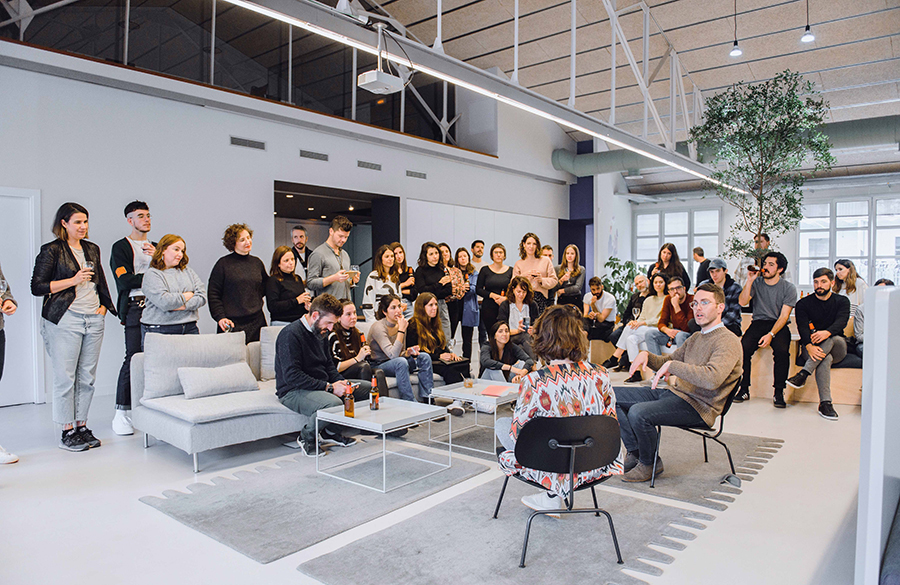In 2020, the world came to a halt, and telecommuting became the only option for companies not considered essential. Since that moment, at Runroom, we have brainstormed and explored possibilities to find the most suitable work system and space for our team: a hybrid model that meets all our needs. Do you want to know where we stand and how we got here? We'll explain it to you in the following paragraphs, with the hope that our journey can help you make decisions and avoid the same obstacles we encountered if you choose to change your model.
This is how we were until the lockdown arrived
From the moment Runroom was founded in 2003, until the COVID-19 pandemic hit in 2020, our work model was the one prevalent in most companies: the in-person model. Being able to see each other, share spaces, create and maintain a Runroom culture was highly significant. Nevertheless, we always allowed some flexibility to promote work-life balance, so working remotely on occasion was possible.
At Runroom, we already had some runroomers working remotely, which greatly helped us identify certain drawbacks, such as the challenge of conducting meetings when other participants were present in person. This experience also helped us develop work processes that allowed remote team members to work efficiently. At that time, we were already using tools to visualize project progress and sharing methodologies and channels that facilitated asynchronous communication.
This prior experience made us better prepared before the lockdown. In fact, on March 11, 2020, we conducted a general rehearsal, and everyone worked from home to confirm that it was possible to continue remote production in the event of a lockdown. The surprise was that after this test, we didn't return to the offices for a long time.
Ensuring that everything functioned smoothly when transitioning from an in-person model to a remote one in a team of nearly 60 people was a complex challenge. On a technical level, it required implementing an internal server infrastructure to maintain a secure connection between the staff and clients, as well as providing computers to the entire team. Another critical element in the "in-person to remote" transition was having a well-established work methodology and a culture based on trust rather than surveillance.
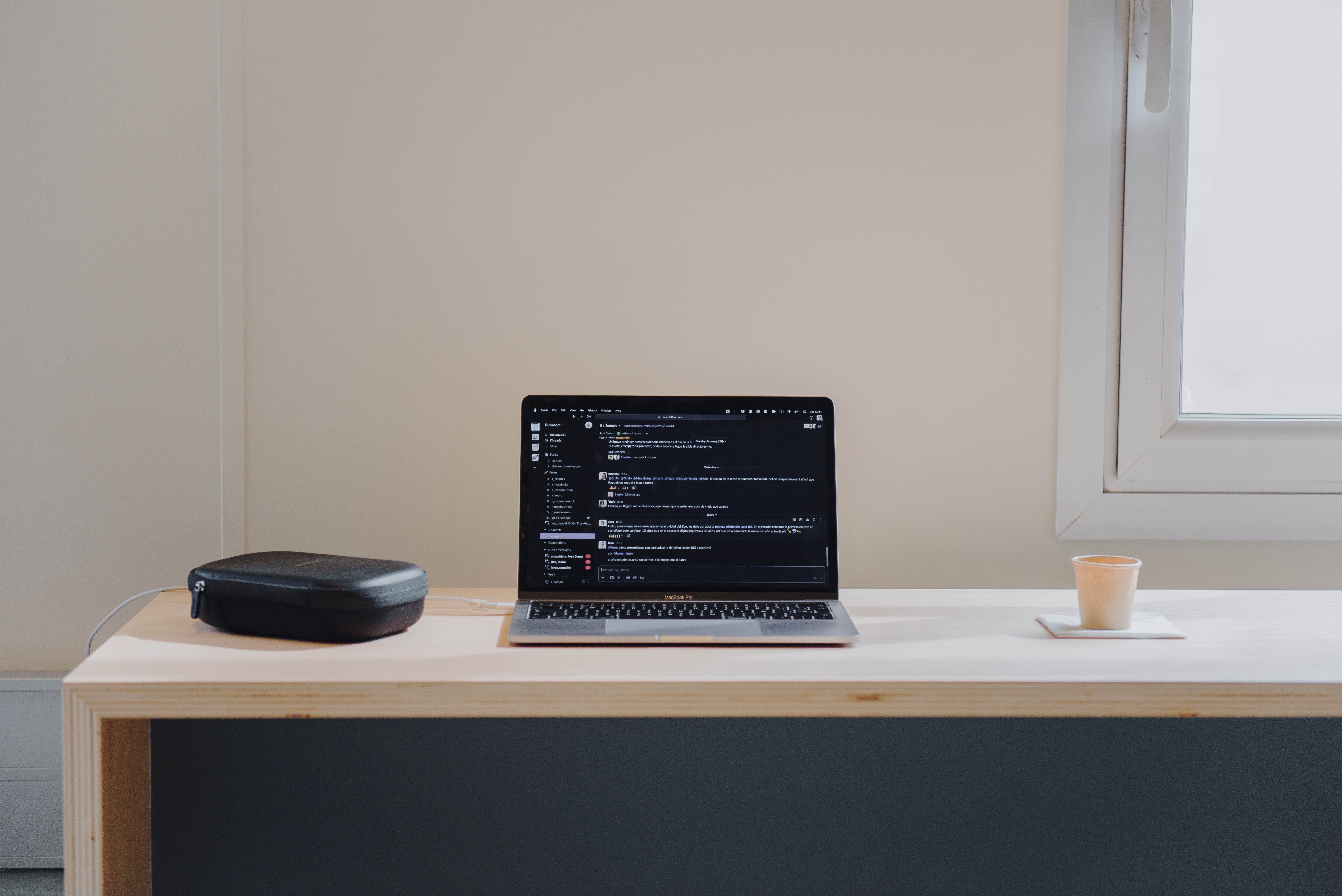
Far and connected, but... How connected?
The runroomers were connected from home, and everything worked perfectly; our processes were running smoothly, so from a business perspective, we didn't experience any crisis or delays in client deliveries. Additionally, all staff received the materials and personal items left in the office, such as an extra monitor, an ergonomic chair, or any other materials needed for comfortable work. We also considered the expenses that could arise from working from home, which is why we provided a monthly stipend as compensation from the very beginning.
In October 2020, we wanted to assess the extent to which these months of lockdown and remote work had affected us and whether everyone was comfortable. Therefore, we conducted a fishbowl session to analyze the pros and cons of remote work, gauge the team's sentiments, and ponder a potential return to the office. Could a hybrid model be possible?
During this meeting, we observed that people were interacting less with each other, especially with colleagues from other teams. There were no longer those chance encounters in the hallways or impromptu conversations while making coffee or heating up a packed lunch. To prevent the loss of human connection and Runroom's unique culture and essence, we had initiated various activities and games from the beginning of the lockdown, allowing those who wished to share personal anecdotes, childhood photos, their desk setups, their view, whether they had pets, or their work-from-home outfits, to spark conversations beyond work-related topics. Nevertheless, despite all these efforts, physical distance had taken a toll on interpersonal interactions, and this was the catalyst for maintaining the idea of returning to a physical workspace.
The company tried to overcome the uncertainty that permeated everything in that unforgettable 2020 by fostering a sense of belonging and contribution among the staff, listening to everyone and acknowledging their achievements. On the other hand, there was ongoing contemplation about how to proceed regarding a potential return to in-person work, without reaching any definitive conclusions, while paying close attention to the market and the decisions of other companies.
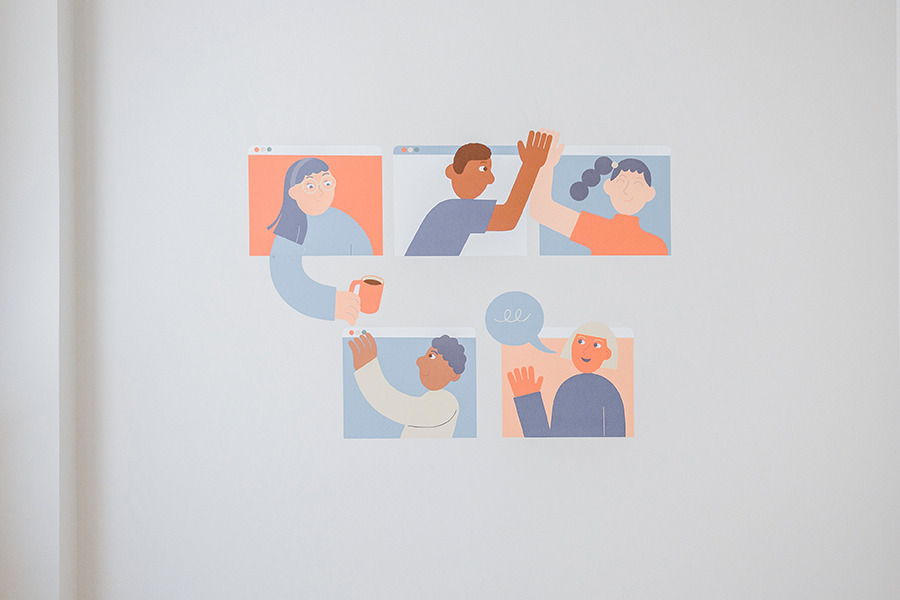
2021, Do we return or not? What about a hybrid approach?
The pandemic continued its course, and before we knew it, we had arrived in 2021. Following the recommendations and guidelines of health authorities, many companies were in the process of de-escalation and returning to in-person work. At Runroom, we felt very comfortable with remote work to the extent that, for the first time, we opened up recruitment processes for various positions without requiring residence in Barcelona. We were seeking talent regardless of their postal code!
Nevertheless, we always had a potential return in mind, even though we didn't have a specific date. It was essential to understand how many people would be interested in coming back to help us find a new space that would cater to our new needs.
In mid-2021, we conducted a survey to determine what runroomers wanted, and 59% opted to continue telecommuting. However, 46% expressed an intention to visit the office at least once a week, and 13% sought to maintain total flexibility. 29% of the staff voted for having a half-week of in-person work. The numbers spoke for themselves: the hybrid model was the solution.
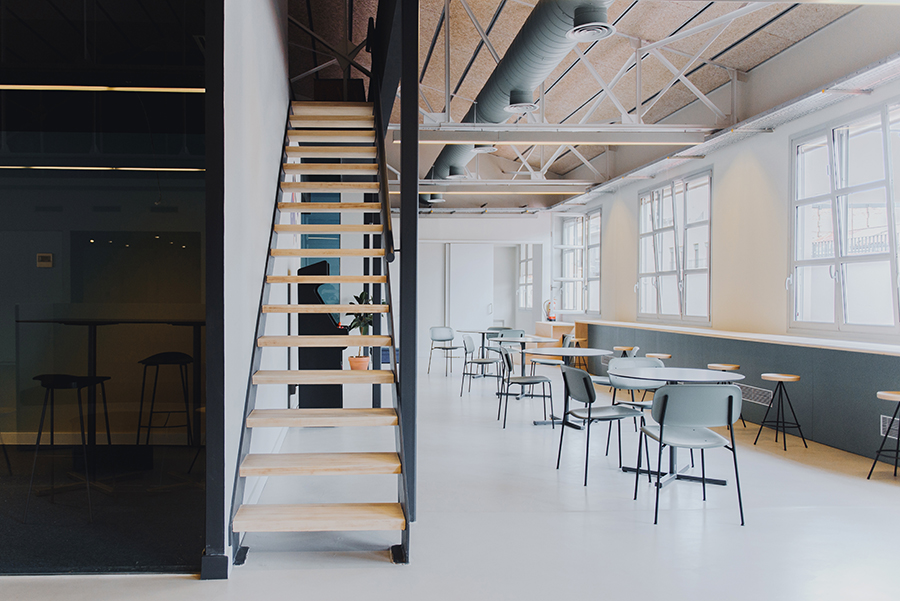
And the winner is... the hybrid model!
What is it, how does it work, and what advantages does it offer over the in-person or remote models? There's a wealth of literature on this topic. We recommend this article by Salesforce, which delves deep into the characteristics and types of the hybrid model, its impact on company culture, and the technology and technical requirements to consider when implementing it.
Once the team's sentiment was known, we needed a thorough analysis of the benefits of both models and what they could bring to Runroom:
The in-person model:
- Strengthens personal relationships and the enrichment it brings to the group.
- Provides greater ease for collaborative in-person dynamics, workshops, training, and team-building activities.
- Allows for the experience of sharing everyday life in a common, open, bright, and pleasant space, going beyond work.
The remote model:
- Fosters flexibility and greatly aids in work-life balance.
- Enables maintaining a dedicated space for increased concentration.
- Reduces environmental impact by minimizing commutes, including meetings with clients.
- Expands talent acquisition possibilities by broadening the geographical scope to the entire national territory.
For its implementation, our approach has been to flow and give complete freedom to the runroomers without imposing anything; coming to the office is voluntary, and if we do so, there are no restrictions on the number of days or specific days.
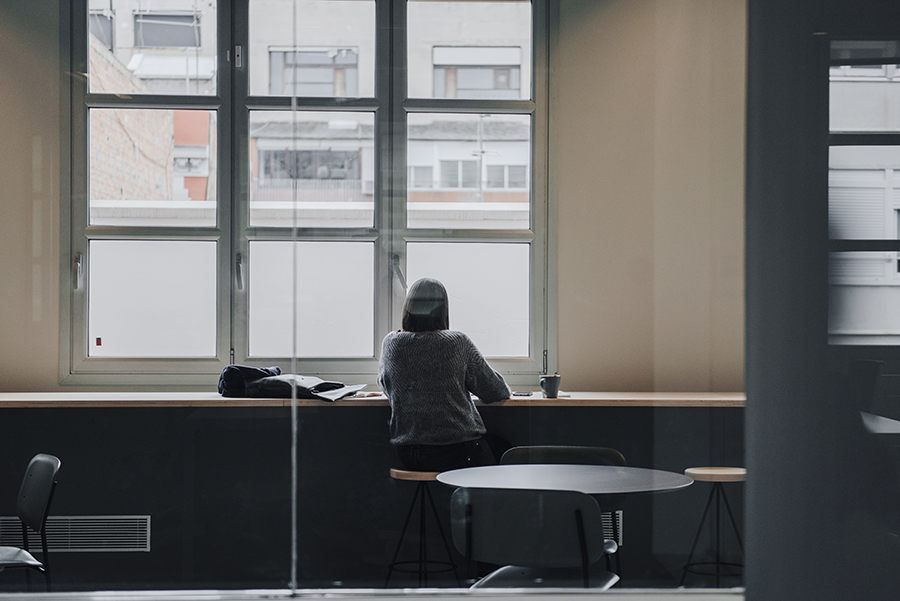
To ensure smooth day-to-day operations, regardless of our location, we use various tools that facilitate communication and teamwork. The main ones include:
- Slack for internal team and client communication.
- Miro, a visual collaboration platform for teams.
- Google Workspace with all its components: Calendar, Drive, email...
- Zoom for video conferences.
- Officevibe, a survey system that helps listen to and measure employee satisfaction.
- Leankit, a virtual Scrum and Kanban board system for visually managing workflow.
- Stooa, an online tool for monthly fishbowl discussions.
- Figma, a graphics editor accessible to the entire team to view and contribute to design work.
- Loom for asynchronous reviews or demos, ideal when scheduling with large groups is challenging.
The organization is striving to make everything function smoothly among teams, regardless of each person's location, while maintaining the sense of belonging and Runroom's culture and preventing anyone from feeling isolated when working remotely.
During our contemplation of the return to the office and which model to adopt, we found some inspiring texts that helped us make decisions, such as the article "What executives are saying about the future of hybrid work" by McKinsey, "Google's 3-Word Plan for Returning to Work Is the Best I've Ever Seen" by Jason Aten, and "Google’s Plan for the Future of Work: Privacy Robots and Balloon Walls" by Caycee Clifford.
Change of location, the icing on the cake for a sweet return
When we envisioned the return, we also envisioned it in a new workspace and a place for meetings and gatherings, but also for leisure and connection. This space wouldn't just be for all the people who make up Runroom but also for the various communities we are a part of. We dreamed of a place to host events, celebrations, workshops, and training sessions where we could share knowledge and learn.
With this in mind, we reached out to Raquel Ruiz de Gauna and Roger Ferran from the interior design studio 0,2 Interiors. They understood our essence and desires and got to work translating them into every detail of the new location.
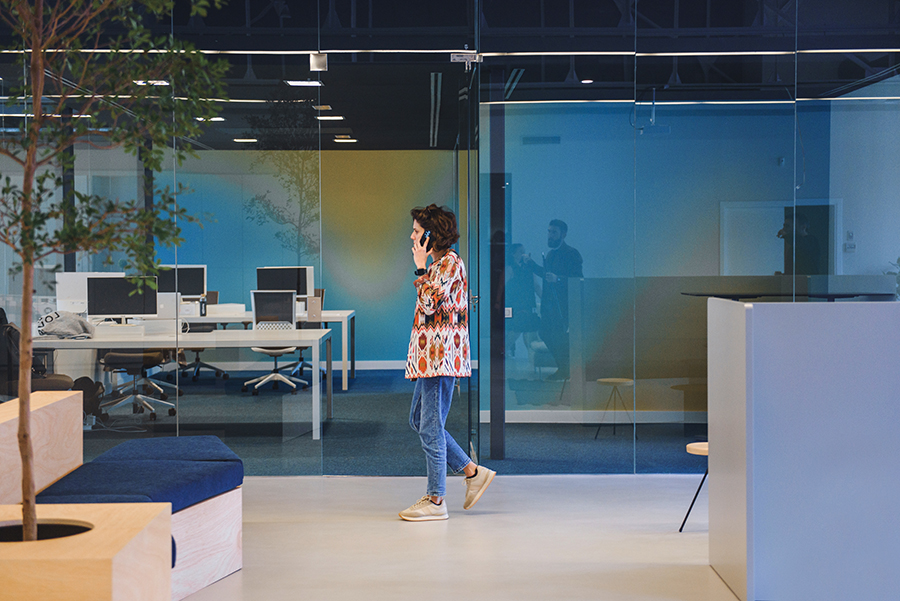
Here is what they wanted to share with us about the project:
What did you think of the project?
It was very motivating and attractive. We were excited because it was a company like Runroom and a space with certain aesthetic characteristics that needed updating and adapting to new team and work system needs.
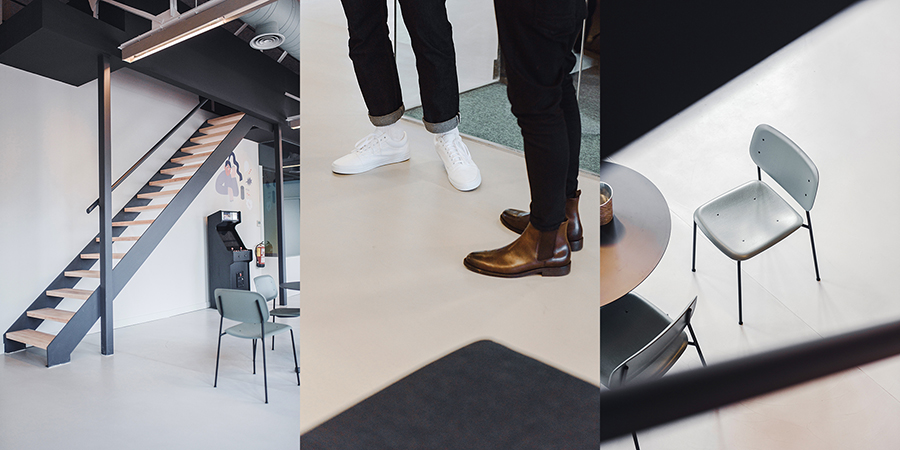
What was the challenge?
For us, it represented a significant challenge because it was an emerging company that is in constant evolution and values its employees greatly. Design is a part of its DNA and has always been reflected, both in its offices and in all the work they do. The goal was to create a versatile multi-space adapted to a new way of reconciling work at home with work in the offices, where individual or team work, courses, various events, as well as leisure and relaxation for the Runroom team coexist.
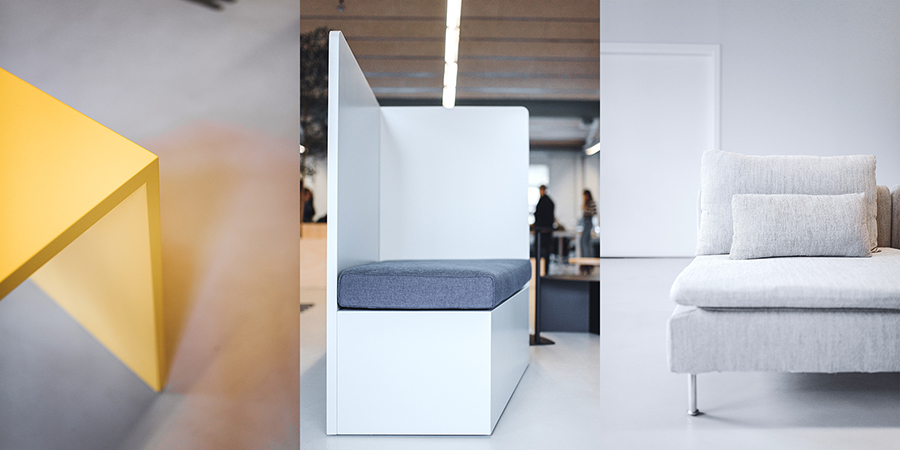
The first input we received was to create an office where one would want to go to work. Since the beginning of the pandemic, everyone had been working remotely, and it was time to partially bring back in-person work to create synergy between teams. The idea was to create an environment where work wasn't the only focus and to make the space inviting to attract talent.
How did you capture the essence of Runroom and how did you incorporate it into the project?
To tackle the project, we studied many open-minded office design references and drew inspiration from concepts used in sustainable design. The use of noble materials like wood and the incorporation of greenery were meant to take center stage against the neutral-toned continuous flooring we had selected.
When we were asked to incorporate the "brand" image into the office, the first thing we did was thoroughly study the style guide. As soon as we understood that this image was flexible and could adapt to various uses, we realized that we shouldn't just apply it to a plan but could play with it in a more immersive way.
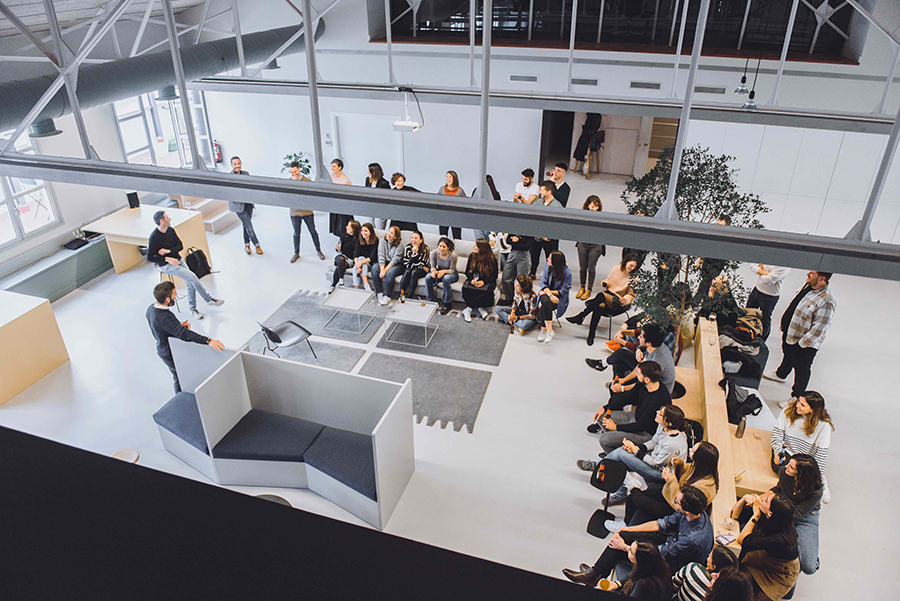
We decided to apply the Runroom brand's identity color to both furniture and some structural elements and decorative lighting, representing the concept of Runroom's image, which is the contrast of warm with cold. This contrast is present in different elements: the contrast between daylight for the work area and technical lighting and the warm temperature of decorative lighting in the leisure and relaxation areas.
Was it crucial to understand the hybrid work model in order to design the office?
Understanding the hybrid work model was essential for designing and configuring the space, selecting and designing every element. We needed to create and maintain multiple rooms for meetings of various sizes and reserve the large space for courses, talks, and events. We also established a dressing room area with a shower to facilitate and provide a service to those who wanted to exercise during the workday.
The goal was to create a space adapted to multiple ways of working, where each Runroom team member had a suitable space for their specific work needs and working style, as well as rest time. We have returned several times, and the feeling we have is that we have achieved the objective. The work environment varies, and the space adapts perfectly to the hybrid work model.
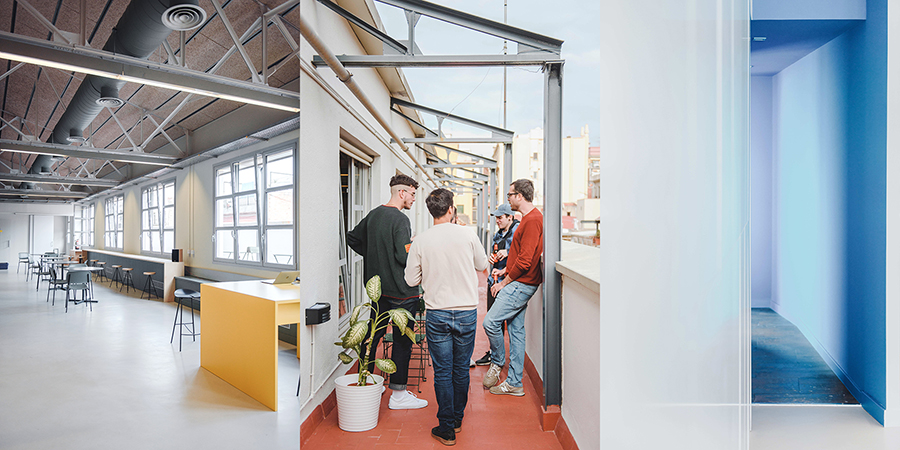
With all these new amazing spaces, a terrace for sunlit lunches, a grill, and our beloved pets (yes, there's room for our furry friends too), we were finally ready to fully enjoy our second home in Barcelona.
Among our most immediate challenges is to give as much life as possible to the new space and strengthen the social bond among all Runroom team members with the hybrid model. To achieve this, we actively listen, trying to understand the team's feelings and needs, frustrations, suggestions, and opportunities for improvement.
One of the tools we've used is an open survey from March to October 2022, which has revealed some important data, such as:
- 71% of participating Runroom team members believe that we have been able to maintain the team's values and culture while working with this model. 26% think we've done so to some extent, and 4% think not as much.
- Runroom team members rate the quality of their relationships within their team or project at 8.2 and their relationships with people from other teams at 7. This shows that there is room for improvement, and we are already working on it.
- The main motivations for the future as a hybrid team include work-life balance, quality of life, meeting people from other places, attracting talent, being part of a diverse and adaptive team with a common goal, and being able to work from anywhere in the world.
While the overall assessment is positive, we take everything from this survey very seriously. In fact, our intention is to keep it active so that feedback continues to reach us continuously, allowing us to work on improving the Runroom team members' experience in every way possible and make the hybrid model a perfect fit for us.
